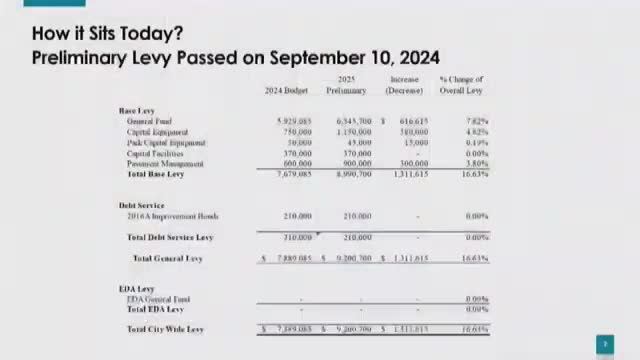City of Dayton faces $87 tax hike due to fiscal disparities in metro area
November 26, 2024 | Dayton City, Hennepin County, Minnesota
This article was created by AI summarizing key points discussed. AI makes mistakes, so for full details and context, please refer to the video of the full meeting. Please report any errors so we can fix them. Report an error »

In a recent budget work session held by the City Council of Dayton, officials delved into the complexities of the city's tax levy and its implications for residents. The meeting, which took place on November 26, 2024, highlighted the challenges and changes stemming from the preliminary levy approved earlier in September.
The council revealed that the 2025 preliminary levy stands at $9.2 million, reflecting a significant 16.63% increase. This rise was intended to maintain the tax rate for homeowners at 35.53%. However, the reality has shifted, with the tax rate now projected to climb to 37.265%. As a result, homeowners in Dayton are facing an unexpected increase in their property taxes, with the average homeowner seeing an annual rise of $87, bringing their city tax portion to $20.25.
A key factor in this tax increase is the fiscal disparities program, established in 1971 to redistribute tax capacity from areas with substantial commercial and industrial development to those with higher residential populations. Dayton, which contributes 40% of its commercial and industrial tax capacity to this program, found itself on the losing end this year, with an $800,000 net loss in tax capacity. This situation underscores the ongoing debate about the fairness of the fiscal disparities system, which benefits cities like Brooklyn Center and Champlin while penalizing those like Dayton and Rogers, which are experiencing growth in commercial development.
As the council navigates these financial challenges, the implications for residents are clear. The discussions reflect a broader struggle within the metropolitan area, where the balance between commercial growth and residential needs continues to evolve. The council's efforts to clarify these issues are crucial as they prepare for the upcoming budget and seek to address the concerns of their constituents.
The council revealed that the 2025 preliminary levy stands at $9.2 million, reflecting a significant 16.63% increase. This rise was intended to maintain the tax rate for homeowners at 35.53%. However, the reality has shifted, with the tax rate now projected to climb to 37.265%. As a result, homeowners in Dayton are facing an unexpected increase in their property taxes, with the average homeowner seeing an annual rise of $87, bringing their city tax portion to $20.25.
A key factor in this tax increase is the fiscal disparities program, established in 1971 to redistribute tax capacity from areas with substantial commercial and industrial development to those with higher residential populations. Dayton, which contributes 40% of its commercial and industrial tax capacity to this program, found itself on the losing end this year, with an $800,000 net loss in tax capacity. This situation underscores the ongoing debate about the fairness of the fiscal disparities system, which benefits cities like Brooklyn Center and Champlin while penalizing those like Dayton and Rogers, which are experiencing growth in commercial development.
As the council navigates these financial challenges, the implications for residents are clear. The discussions reflect a broader struggle within the metropolitan area, where the balance between commercial growth and residential needs continues to evolve. The council's efforts to clarify these issues are crucial as they prepare for the upcoming budget and seek to address the concerns of their constituents.
View full meeting
This article is based on a recent meeting—watch the full video and explore the complete transcript for deeper insights into the discussion.
View full meeting
